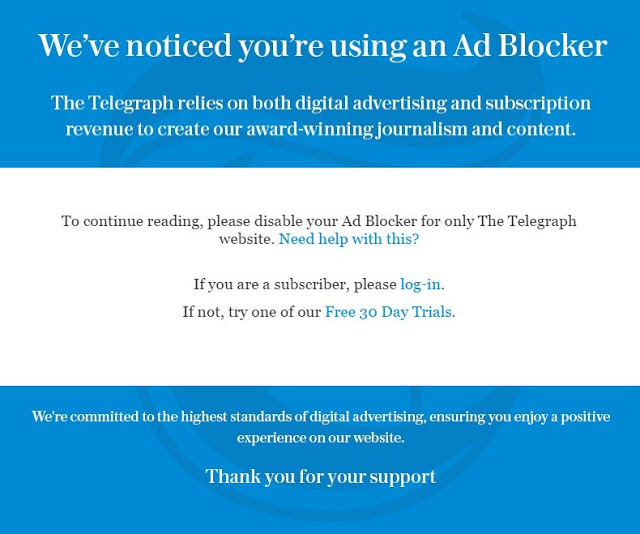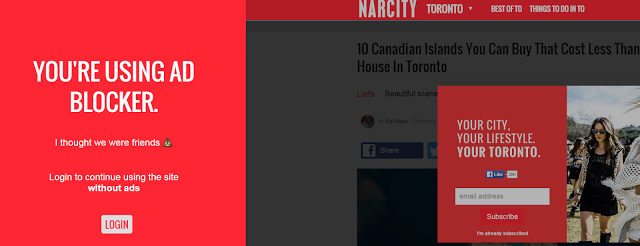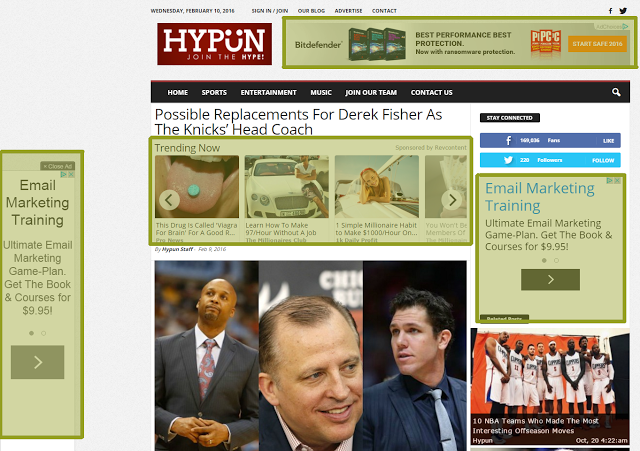Publishers are frustrated and taking action. Readers with ad blockers are increasing in number. Advertisers are questioning paid ads. The online advertising industry is going bonkers over ad blockers.
Surprisingly, ad blockers have just started to take off in the last couple of months. Personally, I’ve been using one for a couple of years now. Yes, I am part of that group that chooses which ads I see and which I block. However, recent publishers have been blocking readers with ad blockers. You may have seen a message similar to the ones below:
Telegraph (British News Website)

NARCITY Toronto
I, myself am not a big fan of invasive pop-ups. While I understand that they can drive results, they can also annoy certain users. If the goal of your landing page is to have someone subscribe to the content via email, a form or field in the right column another area of the page suffices. In the end, it is the quality of the content that will determine the best subscribers.
So, why the recent rise in the use of ad blockers?
- between paragraphs
- in left and/or right columns
- before and after comment section
- pops ups come after a certain level of scrolling
Let’s look at an online sports blog, Hypun and one of their recent blog posts overloaded with ads:
Top (just loaded) part of blog post:
Middle of page (article content):
Bottom of page (usually comment section):
Publishers rely on ads to provide free content

What can publishers do to make things better?

Secondly, if the advertising model isn’t able to meet publisher’s revenue goals perhaps they should consider having a subscription based service. Whereas interested users can pay to access ad-free, well created content while the free articles or previews are only limited overviews of a topic. Ads aren’t the only way to attain revenue, and instead of increasing ad volume to meet those goals perhaps other means of revenue generation should be considered.
What can advertisers do to make things better?

Create better ads. Do not fall into the click-bait trap of creating over-the-top article headlines, poor blog posts or offers. If you genuinely put effort into your ads, they will yield better results compared to trying to find the quickest shortcut to making a quick buck.
Secondly, and just as important is where you place your ads. Targeting not only helps generate better results and return on your investment, but it simultaneously helps eliminate the problem of seeing an ad that is completely irrelevant to that publisher’s content.
What can users do to make things better?

Understand that the advertising model allows everyone access to free and unlimited content on the web (and some of that content is very, very good). While one website may abuse their advertising placement does not mean that every digital space will do so. I willingly turn off my ad blocker on certain websites, as a matter of fact I actually clicked on some of the ads that drew my interest. There is nothing wrong with ads when they are done right.
Another option is if you truly are bothered by ads; don’t visit the website or look for a subscription-based model that is ad-free. Both you as the user and the publisher/advertiser would be better off. We as consumers of all this information have the ability to channel our attention to the right areas, much like our hard earned dollars are channeled to the brands that we trust.Attention is the digital currency.
So where do we go from here?
As you can see from the above points, each party can do a little more to improve the other’s experience or goals. Taking these steps will help rid the web of inefficient web pages, ads and everything that has led to users relying on ad blockers. Obviously we can’t eliminate every single spam site, and that is the same reason we can never eliminate the use of ad blockers. We can just encourage where they are used.




